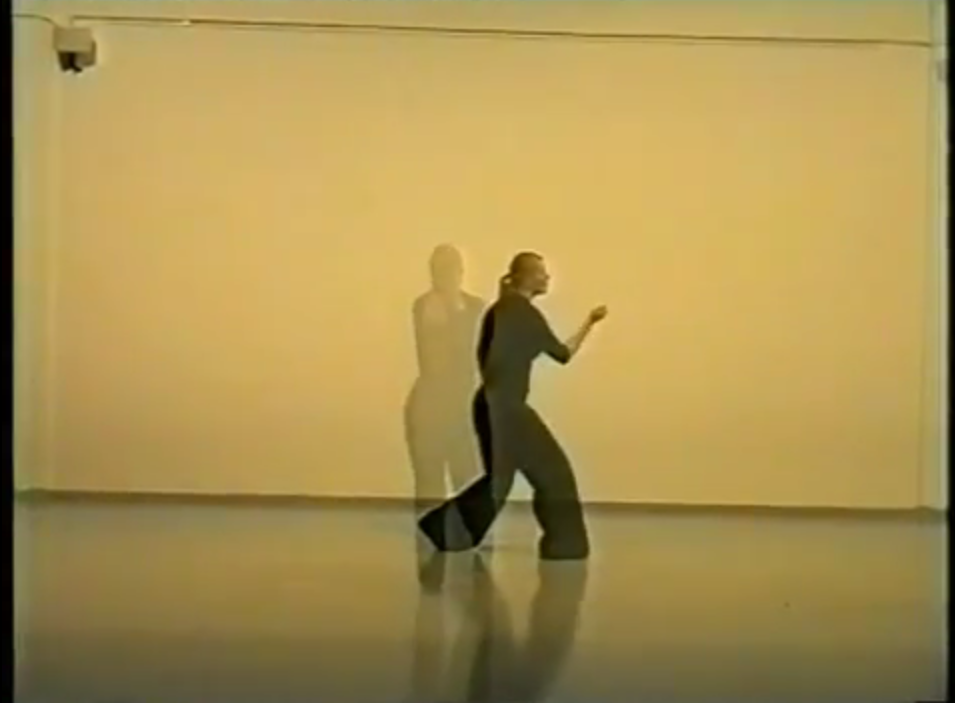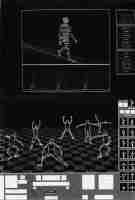With this text on dance and architecture I embark in an area where I as an architect and writer am not familiar with. By surprise there seems to be an interface between the two arts, namely space. Yes, the dancer also knows a space, the space of dance, which we will come to speak about at length, even though it is quite different from the space of architecture.
Being occupied with matters you are not an expert in, is the core of dilettantism. We must remember however, that in the past the dilettante rather than an inexpert was a loving amateur.
I am a lover of dilettantism because it allows a different movement of thought than expertise.
Maybe I can put it this way: where the expert strives forward and aims for a development that is sought, the dilettante steps aside and may bump into something unexpected.
It was after all the Italian dilettanti in the wake of Napoleon during his Egyptian campaign, which eventually made possible the decryption of hieroglyphs.
READING WITH THE BODY; Press on the image to see the movie
1. LABANOTATION AND THE PRINCIPLE OF FALLING
1.1 Basic Principles of Labanotation
Rudolf (von) Laban has become famous for his studies for a universal dance notation. He summarized some of his theoretically most developed thoughts in his so called “choreutics”. This teaching of dance and her notation has been republished in German in 1991 under the title: Choreutik, Grundlagen der Raum-Harmonielehre des Tanzes.(1) The English original was published in 1966. (2) Its theory has been developed in period 1922 to 1930 when Laban was active in the Bauhaus. After a prolonged interruption, he elaborated his initial thoughts in England in the 1940s.
His universal dance notation system is based on two sensory elements: the weight of the dancer, his living body and the quality of the flux, the energy that drives the movement.
1) “The play of spatial lines, which departs from the body of the dancer”, Choreutik, 1991
2) “The kinesphere, the point of view, the cube and the diagonals”, Choreutik, 1991
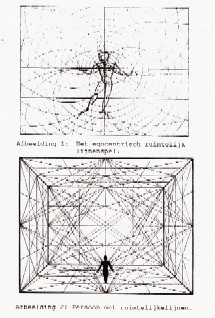
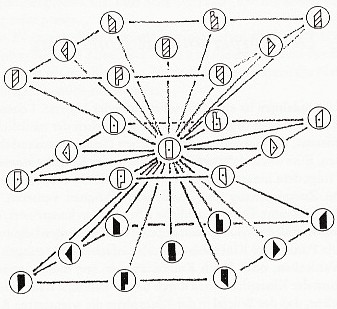
-
THE SPACE OF DANCE IS SHAPED BY A MOVING BODY, WHICH IS ALWAYS IN THE CENTRE.
-
THIS CENTER IS SURROUNDED BY THE KINESPHERE, A SPHERICAL SHAPE, WHICH IS SHAPED BY EXTENDING THE LIMBS FROM ONE POSITION. THE POSITION IS DEFINED BY THE PROJECTION OF A PERPENDICULAR LINE WHICH RUNS DOWN FROM THE GRAVITY CENTRE OF THE BODY AND IS EMBODIED BY ONE FOOT. IN EACH SITUATION OF THE KINESPHERE THIS FOOT IS FIXED ON ONE SPOT IN SPACE. IF THE DANCER TAKES A STEP WITH BOTH FEET, A NEW KINESPHERE IS CREATED ON A NEW POSITION IN SPACE.
-
LET’S IMAGINE A CUBE, THAT CIRCOMSCRIBES THE KINESPHERE. ON THIS CIRCUMSCRIBING CUBE COORDINATES ARE PROJECTED THAT INDICATE THE DIRECTIONS TO WHICH THE DANCER POINTS WITH HIS LIMB. A SEQUENCE OF SUCH COORDINATES SUBSEQUENTLY DESCRIBES A MOVEMENT ON THE SURFACE, OR IN THE SPACE OF THE KINESPHERE.
-
TO ACCENTUATE THE GRAVITY CENTRE OF THE BODY, LABAN CONSTRUCTS A SYSTEM OF DIAGONALS THAT CROSSES IT AND EXTENDS TO ALL THE COORDINATES OF THE CUBE THAT CIRCUMSCRIBES THE SPHERICAL SHAPE OF THE KINESPHERE.
1.2 The Reality Principle of the Moving Body
The space of dance originates from a moving body. Because she is the result of the moving body, she has a higher degree of reality than architectural space in the strict sense. This difference is determined by the nature of visual perception and the type of geometry which are necessary to determine a space. The space type in which architectural forms are projected is Euclidian. It consists of geometrical volumes, like the cube, the cylinder and the cone, and its perception is organised according to the rules of perspective. In the 17th century the philosopher Rene Descartes analysed perspectival space as the illusion of a depth, which is projected in front of a spectator who is standing still and in which geometrical volumes and cavities are indicated. Perspective always supposes a spectator that stands still and whose physical ability to move is factually not included in the scheme.
According to Laban the space of dance is “more real” than perspectival space because its perception is accompanied by the experience of physical efforts and bodily tensions. Laban calls this combination the “bodily perspective”.
3) “Trace forms”, Choreutik, 1991
4) Example of a classical dance notation: “Mr. Isaac: the Union, 1711”, engraving, Traces of Dance, 1994, 19
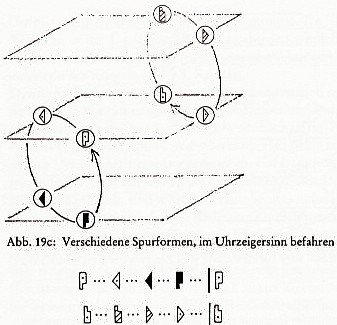
The space of dance is an action space that always surrounds the human body. I already mentioned the geometrical principle of the kinesphere. The action space is composed of special time forms. These can be recognised in space, but are made in time.
Laban specifies these time forms as trace forms. They are composed of ways that the body and its limbs can cover in a certain amount of time. Due to our short term memory and retardation of the retina, we can perceive these ways as lagging, ephemeral, or as quasi static forms.
The space of dance differs from the architectural space because of her relativity. She is a combination of space and time; she is a time-space.
1.3 Notation as a Condition for Research and Analysis of the Human Motion
The great merit of Laban has been that he has developed a general notation system in which all the movements of the human body can be laid down. In his view such a notation was necessary in order to develop a harmonic of motion. He has elaborated his notation system, which has become known as “Labanotation”, in several places and a diversity of publications. In January 2004, during the workshop Reading with the body, we took note of it from his book I already mentioned: Choreutik, Grundlagen der Raum- Harmonielehre des Tanzes (1991) (Choreutics, (1966) 2011)
The word choreutics in the title is derived from the ancient Greek “choreosophia”, which is composed of the word parts choros: circle, and sophia: wisdom or knowledge. Choreosophy was practiced among others by the ancient Greek mathematician and philosopher Pythagoras. She had her roots in the way in which the pre-ancient magical knowledge of life was based upon the wisdom hidden in the circle and the circular. Since Hellenic culture, choreosophy has been divided into three different branches of knowledge: choreography, choreology, and choreutics.
5) Example of a contemporary notation: Merce Cunningham, “Programme Compose”, Traces of Dance, 1994, 39
Choreography literally means: drawing of circles. Nowadays it refers to the design of a ballet. The term choreography also refers to the notation systems that have served dance composers and motion designers hundreds of years as memory support. They were generally developed for personal use. That’s why they can look completely different and sometimes be completely incomprehensible to an outsider.
In order to avoid problems in reading and interpretation, Laban wanted to develop a UNIVERSAL NOTATION SYSTEM. For this purpose he studied more than one hundred of these private alphabets and graphical representations. With a universal science of human motion in mind he called his notation system “Kinetography”. Later it became known as “Kinetography Laban”, or “Labanotation”.
6) “Labanotation, my interpretation”, from the workshop Tastenderwijs (Feeling one's way), Arnhem (Netherlands), 2004
On the basis of this notation system, Laban has developed a knowledge that he ranked under the denominators “choreology” and “choreutics”. Choreology has remained relatively unknown. She is a “knowledge of the circles”, which, in addition to pure geometry, develops the grammar and syntax of a more widely understood language of motion.
Laban interprets choreology as a knowledge that relates the outer form of the motion to the mental and psychological content of the dancer. His view is based on the belief that motion and emotion, form and content, body and mind, resp. soul be inseparable. In Choreutik (1991) he devoted a chapter to this matter entitled “The natural sequences of the dynamosphere”. Natural sequences here are chains of actions that correspond to inner “moods”.
The other science that derived from choreosophy is choreutics. According to Laban she is the practical study of different types of more or less harmonized movements.
At the heart of Laban’s choreutics are well defined sequences of motion, he calls SCALES.
7) Labanotation, “female scale”, Choreutik, 1991 p. 153 (left step 1-6, right step 7-12)
8) Labanotation, “female scale”, Choreutik, 1991, p. 153 (left step 1-6, right step 7-12)
The first image represents the female scale projected in the flat plane. The second image shows the same sequence, but now the drawing represents the trace forms as they occur around the body in three dimensions.
In the film at the beginning of this article you saw how my students performed multiple scales. In the following illustrations, I show their graphical representations.
9) Labanotation, “defense scale”, Choreutik, 1991, p. 49
10) Labanotation, “primeval scale”, Choreutik, 1991, p. 77
11) Labanotation, “male scale”, Choreutik, 1991 p. 159 (I took this image from “Rudolph von Laban, Sketches of the Scales”, Traces of Dance, 1994, 32
Now, what exactly is a scale and what is its theoretical significance?
A scale is a theoretical construction with the pretension to represent reality. Laban defines it as a “harmonized unit of movements”. It derives its significance from its position in the heart of “choreutics”. The scale is choreutics pre-eminent object. Its purpose is to serve the development of a science that wants to formulate universal laws for spatial harmonies, which should also be valid in the case of movements that do not belong to the art of dance. In short, the universal laws also should incorporate the logic of everyday movements. They should gain the same meaning for the art of spatial movement, as harmonics had for music.
Laban considers the scale as the key element of the movement language of the human body that is fit to be mastered by science. What matters, is to detect in specific sequences of the human bodies movements, which always and inevitably occur in a field of tension between cultural will and physical ability, an underlying structure; that is, to discover a chorological order. Thanks to the knowledge of this order the movements could become transparent, meaningful and understandable.
Perhaps choreutics could significantly be developed by using words and drawings, in short, with the noble art of naming, but this was not enough for Laban. A complex system of graphic signs had to compensate for the ever-present failure of the words.
1.4 The Organically Running Motion and Her Degree of Reality
Because their function is the marking down and the study of movements Labanotation and choreutics suppose a relative time space. With that they oppose Euclidian geometry, because in the graphics of static geometry the emphasis is on the immobility of things. In the view of choreutics this immobility is an illusion. It is the product of a making believe that is caused by the photographic observation mode of the human mind. Just like the movie, that other medium of movement art that dominated Laban”s time (the ideas for the Choreutics book are from the 1920s), the mind is capable of isolating and “recording” a single element from the eternal flow of things, and, by using memory, to stop them and provide them with a certain duration of time.
But eventually, according to Laban, the memory also appears to be part of the stream.
In the long run it grows and changes and memories disappear of its grip.
Laban was a real relativist. Einstein was in his mind.
Everything is time space; form and movement are inseparably related to one another.
Laban believes that the moving film rightly refers to the “truth” of a reality, which must be understood as eternal flow of motion. However, film also eliminates this "truth" with its tricks and special effects.
Méliès was the first one to show these possibilities around 1906. About the trick stop he says: "When I made a very prosaic recording of the Place de l’ Opéra on a particular day, an unexpected effect occurred, resulting from a blockage of the film device. I needed a minute to remove the barrier and put the device back on. Meanwhile, the passers-by, the buses and cars had moved naturally and thus had changed their position. Later, when I showed the composite film strip, I saw how a bus of the Madeleine-Bastille line suddenly changed into a hearse. This is how I accidentally invented the movie trick, the stop trick. Two days later, I performed the first metamorphoses of men into women."
According to Laban the public recognises the “unreality” of the film montage in the twinkling of an eye. He proposes to oppose the “improbability” of the special effects that were caused by montage techniques with the reality of the “organically running motion”. In this, the physical movement abilities of the human body play an important role. The “organically running motion” consists of a carefully cut sequence from the endless stream of daily movements, which includes a natural course of smaller motion units. Now it is the task of choreutics to find and understand the natural features of its different phases. Subsequently they can be re-assembled into a “meaningful” sequence in the artwork of the dance, or the form of the “labour action”. If we now return to the scales, they are the practical and conceptual building blocks of such “organically running motions”.
Laban believes that the knowledge of the “organically running motion” has been preserved in labour and combat. In whatever way we tackle these activities, they will always force us to use our bodies. In the past, it was the priests who passed along the knowledge of motions in the fixed sequences and patterns of religious rituals. Later in history this role was taken over by dance teachers and instructors of the martial arts. However their mode of transmission was direct and unmediated. Measurement and analysis were not on their agenda. That’s why Laban proposes that their role be taken over by the choreutic.
Note that the two scales that were presented by my students in the movie were directly derived from the tradition of sword fighting. During the workshop in January 2004 we suspected that the female and male scales also are aestheticised derivations of the tradition of fight. On the other hand, the primeval scale depicts sequences that have been derived from work actions and movements of daily life.
1.5 Motion Perspective (Dynamic Perspective): The Illusion of Stability and the Reality of the Fall
The trace forms and motion sequences of the SCALES are produced by the movements of the human body with its possibilities and its shortcomings. Because of their mediation by the body the scales are determined by a certain standing up against equilibrium disturbances and the compensation of the tendency to fall. Quite a few movements are capable to destabilise and overthrow the body. Falling and its countering are caused by interplay of a will to move and the effects of gravity. Now, a figure in the film, or a figure in the virtual reality of the computer, is also characterized by the will to move, but certainly not by gravity. It is therefore in gravity that the idiom of the scale finds its determining determinant.
It is typical of the scale that it is always bound to the rules of a space in which gravity plays the dominant role. If the shape of the scale does not meet this rule, then, according to Laban, the motion it instructs and represents becomes unreal.
There is therefore no stability in the space of dance. What we call equilibrium can never be complete stability or standstill. At most there can be a dynamic equilibrium that is always the result of contrasting movements. In this sense even our buildings move, be it with infinite slowness. Children, but also the people in primeval times, had an eye for these mechanisms. They see and saw the world from a dynamic and balance-seeking body perspective that always has the effort as its correlation. From this dynamic body perspective, the space of dance derives its reality, a reality that contrasts with the one of architectural space and that challenges the improbable world of the specials effects of cinema.
2. THE DANSER AND ARCHITECTURE
2.1 Space of Gravity
13) Scheme of the oblique order, from “The Function of the Oblique”, AA Publications, London, 1996
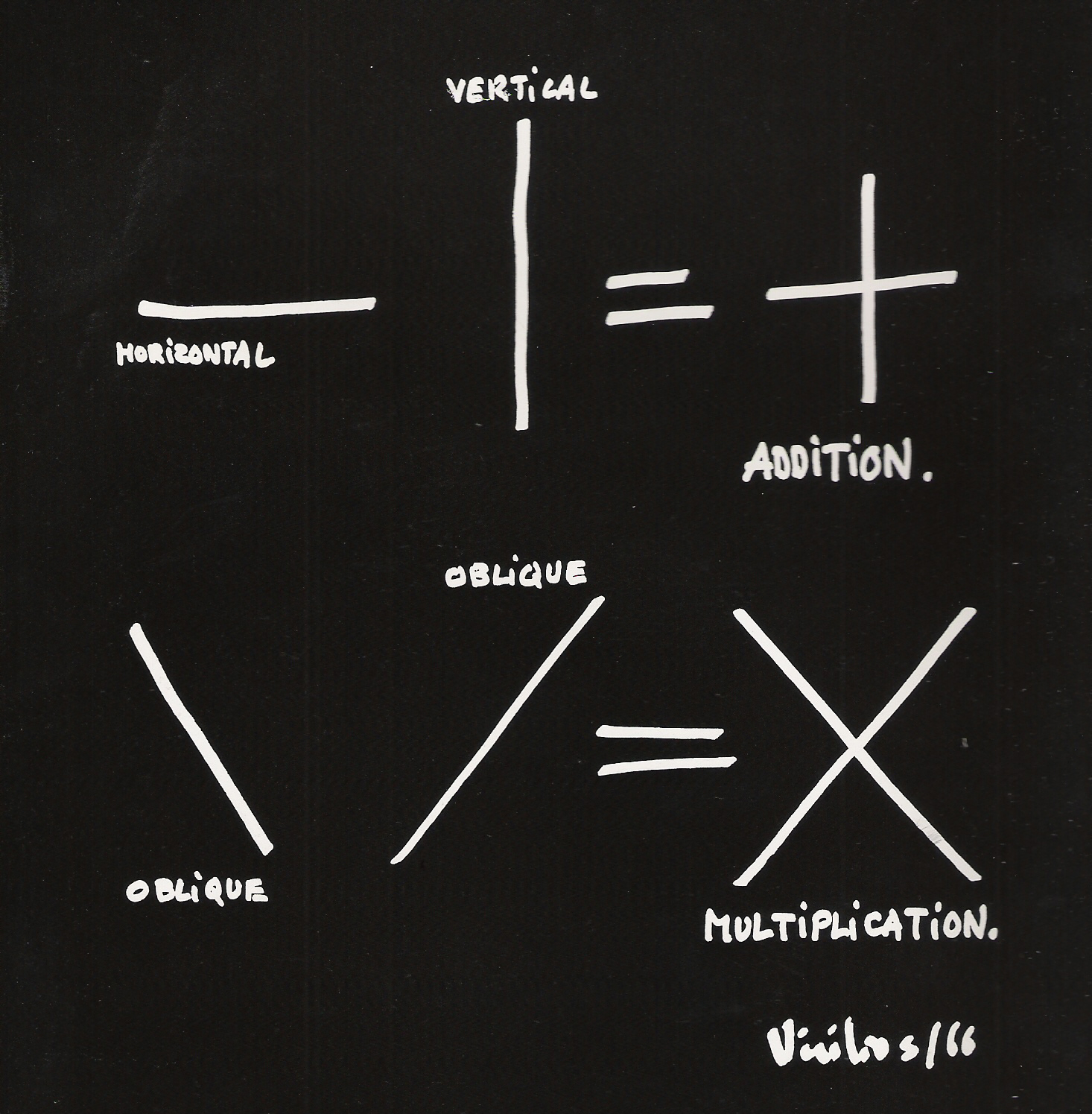 Challenging thoughts about possible relations between dance and architecture can be found in the work of the French philosopher and urbanist Paul Virilio. In a dialogue with dance historian and choreographer Laurence Louppe he develops his groundbreaking concept of gravitational space.(3)
Challenging thoughts about possible relations between dance and architecture can be found in the work of the French philosopher and urbanist Paul Virilio. In a dialogue with dance historian and choreographer Laurence Louppe he develops his groundbreaking concept of gravitational space.(3)
When he was an architect in the 1960’s, Virilio wondered if Labanotation would be able to determine a space of movement that could complement the maps and sections of daily practice in architecture. Even now he finds the world of cross sections and maps through and through barbaric, because they do not take into consideration time.
Choreography, however, has a relativity that is better able to approach reality then the statics of the traditional architectural drawing. This is because in dance notation the representations of space and time are cross linked in one representation.
Would it be possible to supplement and challenge the fixation of architectural knowledge on geography, on the cadastral map and the ground plan, with choreography? If so, choreography would have to make statements about the forms and sizes of buildings. Hereby, the function of Labanotation would shift to quite another function then preparing some body for the gestures it has to make.
It is important to note here that Laban understood movements of the body as a kind of score. According to him, the ordering principle of this score was in the "action", that is, in the displacement of body weight. It is the same principle that incites the conscience, the spirit, of the moving subject, to form a mental map of the area the area that the body has crossed. Because it is based on the movement of the living body through any space, including rising and descending, Labanotation would allow the geography of a space-time in which the architectural space has always been included. This idea results from the notion of "trace forms". At Laban trace forms always imply that a space is formed by changing the gravity centre of the body.
However, this does not mean that the architect should apply Labanotation without further notice. It is more important to get the inspiration from it to better determine, and design, the space of movement. For example, architects could pay much more attention to the space connecting one floor to the other.
Obviously, the experience of body weight is of major importance here.
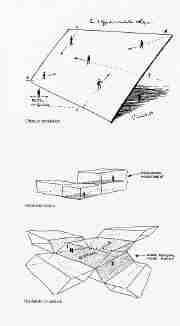
14) The concepts of oblique circulation, habitable stasis and habitable circulation, from “The Function of the Oblique, AA Publications, London, 1996, p.12
15) Claude Parent and Paul Virilio, Mariotti House, Paris, 1966, from “The Function of the Oblique, AA Publications, London, 1996, p.12

The line of thought above has been raised by Virilio during his membership of the Architecture Principe group in the mid-60s, when they were searching for an architectural form, which would generate psycho-physical effects. Instead of striving for balance and stability, to the group’s opinion, architects should purposefully aim for imbalance and fluctuation as means to increase people’s mobility. Cars, television, and other devices made people too passive. It was the task of architecture to bring about change, in particular by consciously using gravity. In order to do so the group developed a program for the so called “oblique order”. Bends, ramps and sloping surfaces served one and the same goal: to bring the human being in motion.
The idea of the “oblique order” was more or less related to the analysis of the International Situationists. As described by Guy Debord, people were captured in the society of the spectacle, which integrated and attached them to the market with images and goods and at the same time isolated them from each other. Here I want to add to Virilio’s remarks, that the International Situationists, including the Dutch artist Constant, who developed New Babylon, wanted to reduce the grip of the spectacle on the people, by creating transient "situations", spatial-social events that could be experienced collectively without social images and image meanings thereby would play a decisive role. They hoped that in this way people could conquer back a part of their own consciousness from a world ruled by the power of images which have become commodities.
Architecture Principe, however, deviated from the program of the International Situationists in so far they did not focus on consciousness but on the body. One of the main effects of the society of the spectacle was that people were isolated in their homes. There they sat in front of the television, surrounded by all kinds of extensions and bodily prostheses. Against this lack of liveliness, produced by the seduction and addiction of the market of comfort Architecture Principe wanted to mobilise the ludic effects of gravity.
16) Female dancer on inclined plane, “The Function of the Oblique”, AA Publications, London, 1996, p. 49
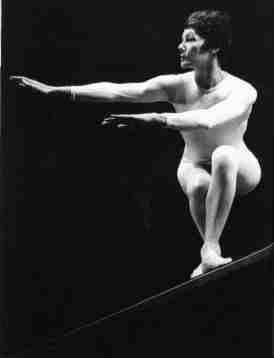
They hoped that movements resulting from a situation in which it would be necessary to offer resistance against the effects of weight, could change into a new form of dancing. The concepts and designs shown above all served to establish a “habitable circulation”, a set of unstable and unity-promoting situations that would promote the permanent movement of the last “metabolic vehicle”: the human body.
This body could fall over,
This body could gracefully grapple with the arms
This body could gracefully fall into the arms of another body.
Since the critical analysis of the 80’s of the last century, we know that such architectural models are not sufficient to weaken the operation of the permanent flux of signs and to detach consumers from the spectacle and spectacle society. All the same they provide critical tools to question two essential elements of architecture, namely the elevator and the flat floor.
Everything that has been designed in architecture since the 80’s of the last century regarding inclining floors and bulging surfaces has been preceded by the architectural culture of the stairway.
Musing about this last remark of Virilio it comes to my mind that this culture might have begun with the stairway designs of the Renaissance and even more with those of Mannerism in Italy, and might have found its preliminary apogee in Modernism, among others in the winding ramps of Frank Lloyd Wright and Oscar Niemeyer.
In the Renaissance stairs and ramps have become a decisive principle of architectural design, able to displace strictly functional elements for reasons of splendour and theatricality. I hope the images I gathered on this subject will illustrate and clarify this topic.
17) Giorgio Vasari, Stairway with Two Flights of Stairs, Designed in Relation to a Reconstruction of the Palazzo Vecchio in Florence, 1561
18) Giovanni Dosio, Plan for Stairway in the Villa Suburbana, Florence, 1580-'90
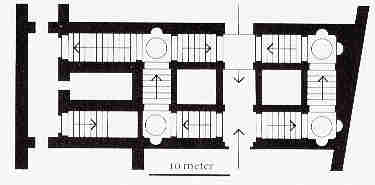
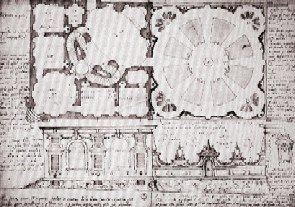
19) Giacomo Barozzi da Vignola, Palazzo Farnese, Caprarola, 1559-1575
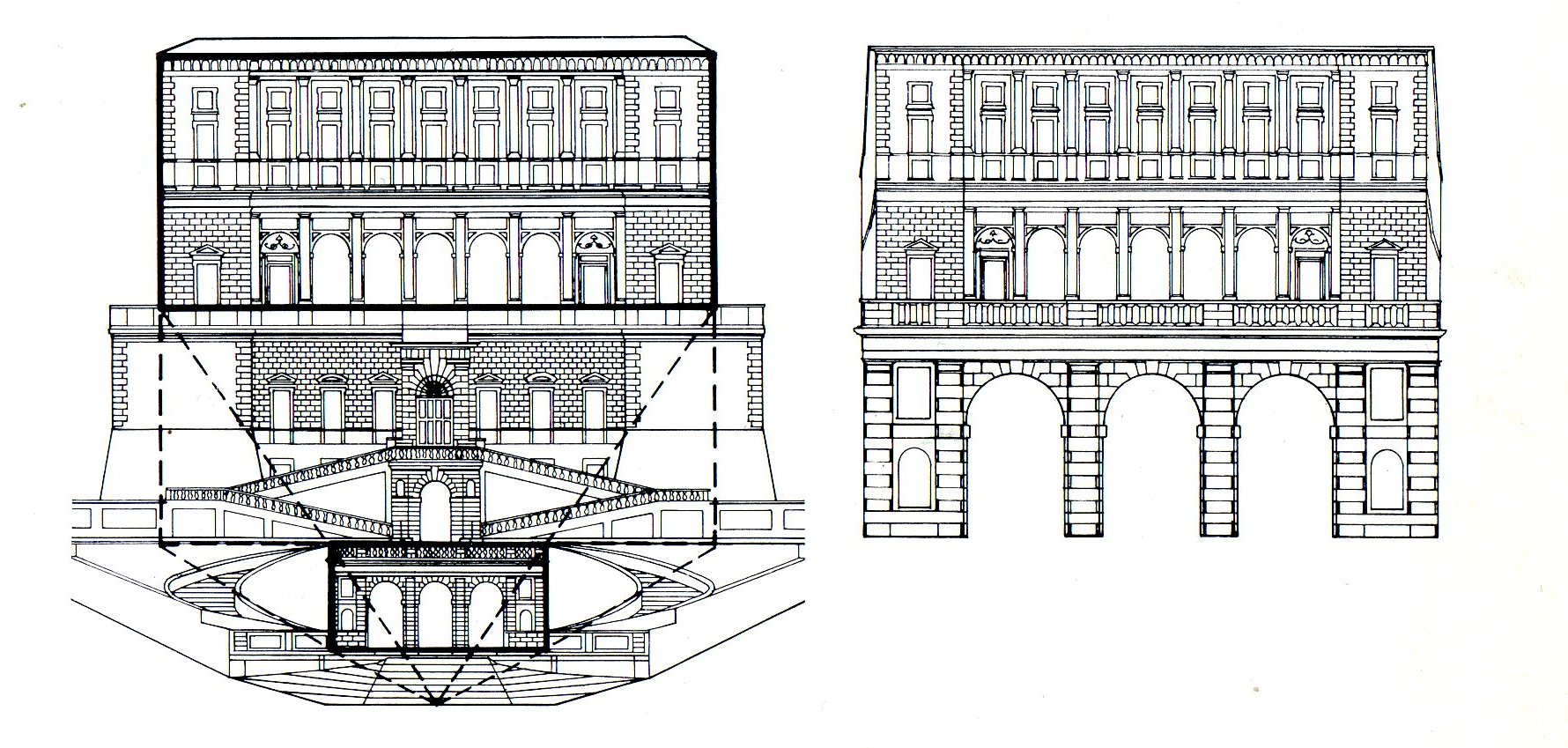
20) Francesco de Sanctis and Alessandro Specchi, Spanish Steps, Rome, 1723-1725 Image by Piranesi
21) Francesco de Sanctis and Alessandro Specchi, Spanish Steps, Rome, 1723-1725
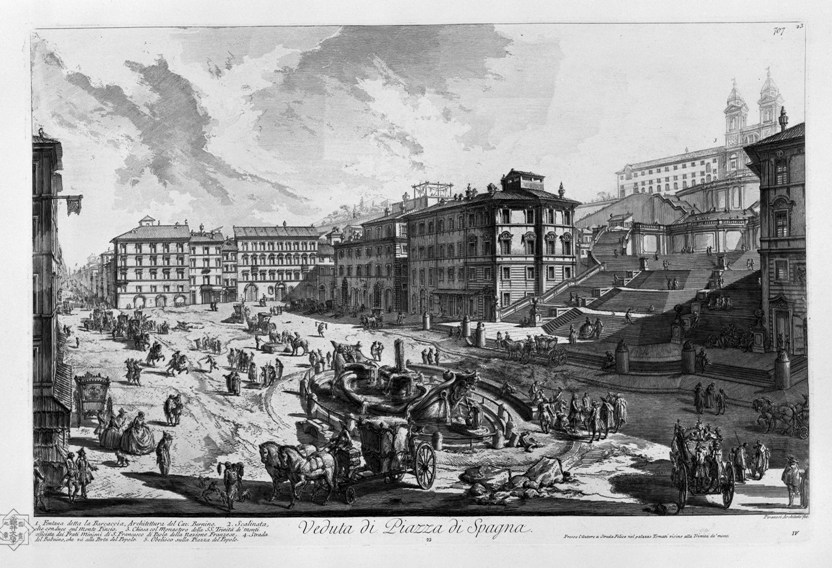
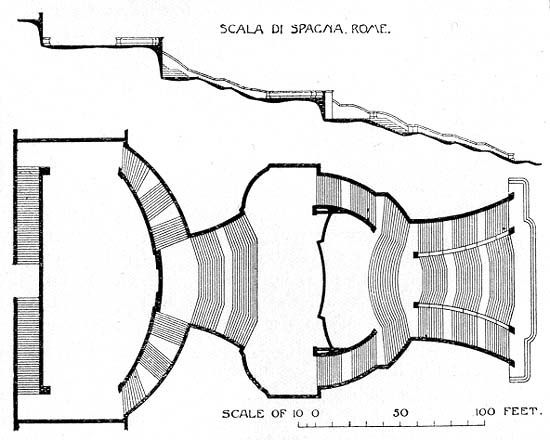
Magnificent stairs and ramps have the magical property to force the human body into their scenario with a soft hand.
Magnificent stairs give their users the feeling to be a ballet master, or a dancer.
The body of the stairway user takes a different attitude and imagination is being unleashed.
The scenario of the magnificent stairs remoulds the stepping movements of the bodies into their graceful mode.
Since the experiments of Mannerism in the 16th Century, a strong relationship has been established between the magnificent stairs and the theatre. The stage settings of that period inspired the stairs of the mansions and vice versa. What matters here is the promotion of a kind of human movement that seeks grace in playing with weight and gravity.
22 t/m 25) Frank Lloyd Wright, Xanadu Gallery (V. C. Morris Gift Shop; predecessor of the Guggenheim Museum), San Francisco, 1948 (Photo Wim Nijenhuis)
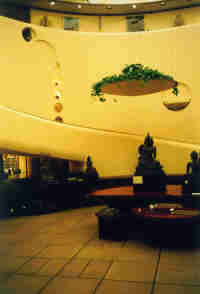
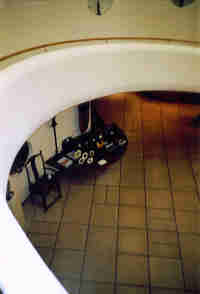
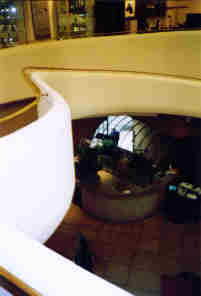
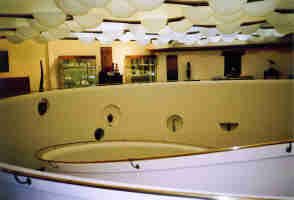
26) Oscar Niemeyer, Ramps in the National Congress Building, Brasilia, 1960 (Photo Wim Nijenhuis)
27) Oscar Niemeyer, Stairway in the Ministry of Foreign Affairs, Brasilia, 1962 (Photo Wim Nijenhuis)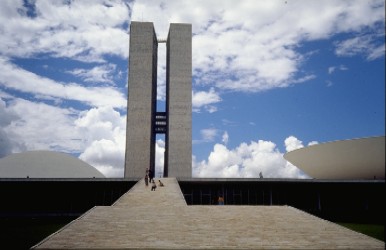
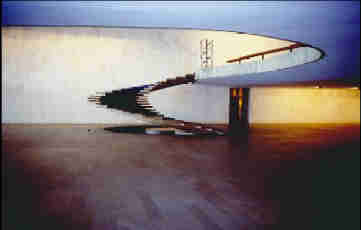
That the human body has weight is of crucial importance for our experience of architecture. The inclining planes of the “oblique order” of Architecture Principe and the stairs and ramps of Mannerism and Modernism not only produce graceful movements, but also bring fatigue into the game. Tiredness makes it impossible for the moving body to be indifferent to its environment. Stairs and oblique planes are even more than tools to combat indifference; they also are capable of causing an imbalance and a propensity to fall in the body’s movements. With these qualifications the circle is round and we are back to the main characteristic of the scale and space of the dancer. The model that haunts in the background of this line of thought is once again that of the dancer.
The particular charm of the dancer on the inclined surface,
The particular charm of the stairs as choreographer,
was lost for architecture when she invented the elevator.
In this regard, I would like to bring to your attention the Parasite project (1989) by the architectural duo Liz Diller and Roberto Scofidio. (4)
At the centre of the work of Diller and Scofidio is the human body, in its capacity as a fatigable entity with a weight. Explicitly, they bring this body in connection with the teaching of ergonomics.
28) Eadweard Muybridge, “Nude Woman Ironing Clothes”, Animal Locomotion, 1887, plate 435
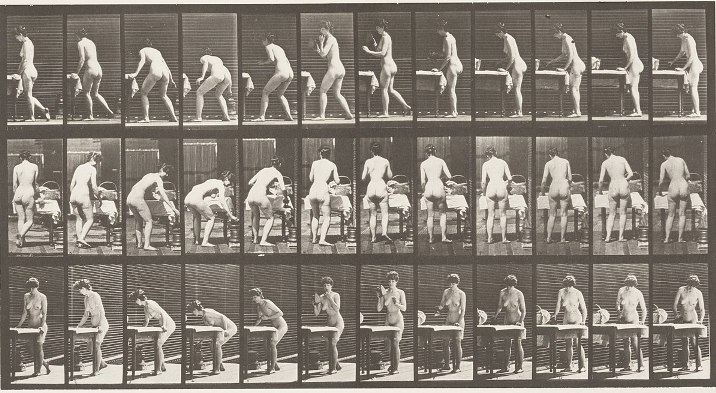
29) Eadweard Muybridge, “Woman Spanking a Child”, Animal Locomotion, 1887, plate 527
http://digitallibrary.usc.edu/cdm/ref/collection/p15799coll58/id/18254
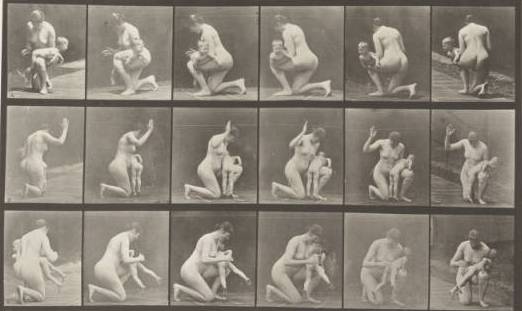
Until now, ergonomics play a central role in architecture. Think of the meaning Neufert’s manuals have in the daily practice of the professionals. Ergonomics is the teaching of proportions and distances, measured according to the dimensions of the human body. The body is the reference to determine the height of the furniture for example.
30) “Parasite: Staircase with CCTV cameras”, Flesh ...
31) “Parasite: Furnished Room, Simulating Weightlessness, with Monitors Showing People Who Get up the Stairs Panting”, Flesh ...
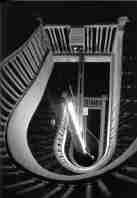
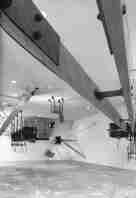
The centrality of the body in Diller and Scofidio equals the position of the dancer in the Oblique Order of Architecture Principe. Although in Diller and Scofidio the body is still bound to the teachings of proportions, daily gestures and its measurements, these has been overwhelmed by the game with its weight.
Stairs and sloping surfaces thus give us a sensation of weight displacement that we do not experience anymore in the elevators and other prostheses of comfort.
This feeling is at the basis of the word GLORY.
GLORY means WEIGHT, or GRAVITY and
not glare.
The pedestrian bridge in Stuttgart Vaihingen by Werner Kaag (arch) and Gus Lachenmann (ing) (5) plays a game with the weight of the living body. The bridge realises her full aesthetic potential when people walk over her. When she is treaded with slightly swinging movements she will modestly respond to this, thus providing a graceful image for the spectator outside and a pleasant experience for the pedestrian in question.
32 and 33) “Photo from the side”, “Photo from below”

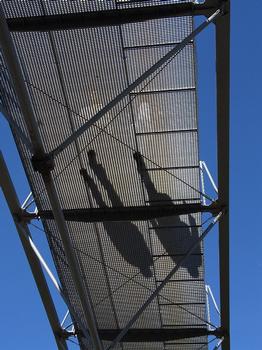
Because the designers wanted the bridge to interact with the loads exereted to her, they neglected the technical requirement of rigidity of the construction. In that way the construction materials could be minimised up to the dimensions needed for sufficient force.
34) “Distortions of the system”, Arch+124-125, 1994
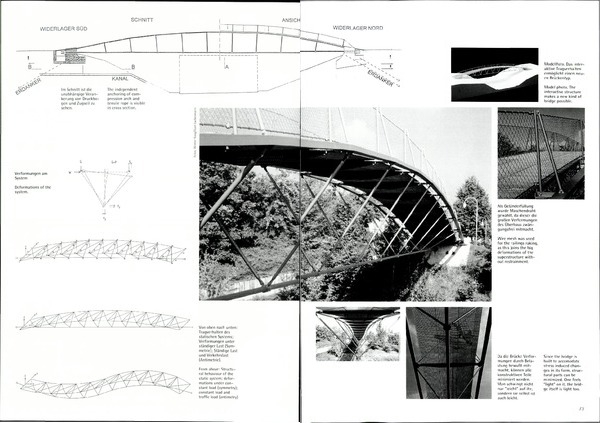
See the three drawing on the left bottom side of the page, from top to bottom :
1. Behaviour of the system under a load when it is static
2. Distortions under: a. a fixed load (symmetry)/ b. a fixed load and a moving load
Gravity determines how we see the world. In this regard, the notion of falling, that in Laban structures the dance movement, is of paramount importance. Geometry of dance and the centrality of the fall allows a critical thinking, allows developing the notion of another space and another role of man.
True, architectural practice has to take action by experimenting with stairs and inclining planes, but theoretical thinking must go beyond these operationalities and should extend the lines that emanate from the dance space into a broader cultural field with its dominant values, norms and definitions.
Critical exercises of thought can be developed as follows (inspired by the writings of Paul Virilio):
We cannot see the world but by falling into it. Human perception is fully dependent on gravity in the sense that we make an essential distinction between falling and not falling. Moving horizontally, like walking, is for the dancer in the spirit of Laban, nothing but falling from one foot on the other. Similarly, the perspective view we have on the horizon is linked to the fact that we are falling towards it. Even the static view of the real space of Renaissance is already conditioned by gravity. The distinction between above and below would have no meaning without the experience of weight. So we might conclude that the perception of the world is preceded by a fall. When Adam and Eve opened their eyes and saw that they were naked, they fell into reality. Perhaps Laban is right and every relationship to reality is determined by an order of falling and thus by the phenomenon of weight.
We have to reconsider the relationship between object and subject. What lacks between these two poles is the idea of the trajectory. This has to be taken literally. We should reinvent the existence of the trajectory and determine its meaning through experiments. The trajectory can be recovered in honour by using gravity and its ability to generate reality. We people are children of gravity. To say that we are earthlings means that we are men and women of the gravity of the earth and not of the moon or anything else.
In this regard we might think of what parachutists call the “fall on sight”, the “chute à vue”. A fall on sight is a free fall where no height meter is used to determine when the parachute must be opened. In case of a fall on sight, one throws himself into the void and fully relies on his own weight to determine when his vision tells him that the parachute must be opened. By the way, in the state of the free fall, weight is in its purest condition. The “faller on sight” (chuteur à vue) pulls the cord when he perceives the ground in a certain way. This observation mode is 100% dependent on the weight of his body. During the fall there are different sequences of seeing. Initially, the ground does not seem to get closer, you have the impression of being in a state of bliss, a nirvana of weightlessness and measureless space, than at a height of about 1000m, the Earth suddenly is not a flat plane anymore. She opens up and shoots up into a three dimensional perspective. Now it is done with the nirvana state. The parachute has to be opened in order to stay alive. In these sequences of vision the velocity of the fall and the distance between the body and the surface of the earth are connected to a shift in the way of seeing. Most likely this is the perspective in its most pure form.
During such a fall, but also during the performance of a dance, people experience a certain degree of dizziness, vertigo. It might be that the expression “vertigo” covers up the experience of the trajectory and therefore the trajectivity of the falling and running man. This is interesting because it gives us a clue that all perception of the world is done during falling and that we only have a worldview because we fall “into the world”.
There is not only a relationship between the dancer and architecture, but also between the dancer and modern technique. The real time of modern communication technique, for example, is only real because it co-operates with the “living presence” of the spectator. Living presence is a concept developed by Husserl: there is only time for who is living present. Dance now is putting into action the dancer’s “living presence”. Although we feel intuitively what living presence, as in the famous Husserlian phrase “living presence of the ego to itself”, means, theoretically it remains a mystery. On the one hand “living presence” is without future and past, but on the other hand it is present in the speed of being in the world and at the speed of falling into the world (in the manner of the falling dancer and the falling parachutist). Although there is no chronology in the “living presence” there still is a kind of timely duration. Concepts like, “chronoscopic time” and “spherical time” denote this exceptional time which is beyond the (chronological) triad of past, present and future.
35) Hendrick Goltzius, “Icarus”, from The Four Disgracers, 1588
36) Yves Klein, Leap into the Void, 1960
https://www.metmuseum.org/toah/works-of-art/1992.5112/

37) Giovanni Bologna, Mercury, c. 1564-80
https://www.bluffton.edu/homepages/facstaff/sullivanm/bargello/mercury.html
https://www.allwicca.com/top-collection/mercury-hermes-greek-statue-3141
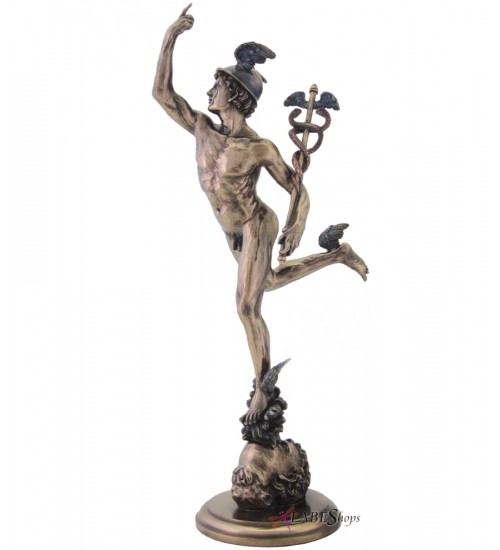
The fall is surrounded by negative meanings, which arise from a false remnant of pride in the biblical sense. What falls, or what is accidental, is commonly perceived as less. We should review this: The first accident was a blessing; we exist because we reside in its space; we exist because we are sinful. We are, because we are accidental, man in the middle of the fall, falling man.
Behold our greatness, which we can derive from the dancer.
Futurism conceived the fall in the world as an attack on the world. This view was taken over by Nazism. We also find it in Heidegger’s essay: The Age of the World Picture (6). But we should note that falling into the world is not the same as attacking the world. The movement might be the same, but its interpretation is completely different: when falling into the world would be an attack it would be the exertion of violence. The Nazis reshaped this interpretation of the fall into a conquering attack. But the dancer and the parachutist are of a completely different order: to acquire the world they take a risk. The parachutist who throws himself into the emptiness wants to gain the world with his weakness: his action is an anti-attack.
If the fall is the key for our access into the world, what then could be the status of floating and jumping? If we value the fall as positive, they seem to become negative values. We might avoid this by not only understanding the fall as a movement from top to bottom, but also from bottom to top, such as in the jump and in the horizontal movement towards the horizon, such as in walking and running.
The jump is an upward fall, just like fleeing is a reversed attack. In the fall, we cannot designate any other centre then the “living presence” of the dancer/ jumper. There is no other centre and ... there is no ground. If we accept that walking is a kind of falling towards the horizon, then there is no ground. The ground is a relative phenomenon; it only exists in the person, the person who falls top down.
38) Stelarc, Third Hand, Yokohama, 1980
https://erinmizrahi.files.wordpress.com/2010/05/stelarc.jpg
http://stelarc.org/?catID=20265
39) Stelarc, Re-Wired / Re-Mixed: Event for Dismembered Body, Perth, 2015
http://stelarc.org/?catID=20353
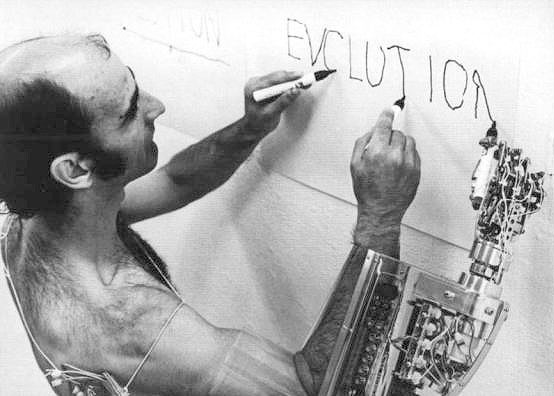
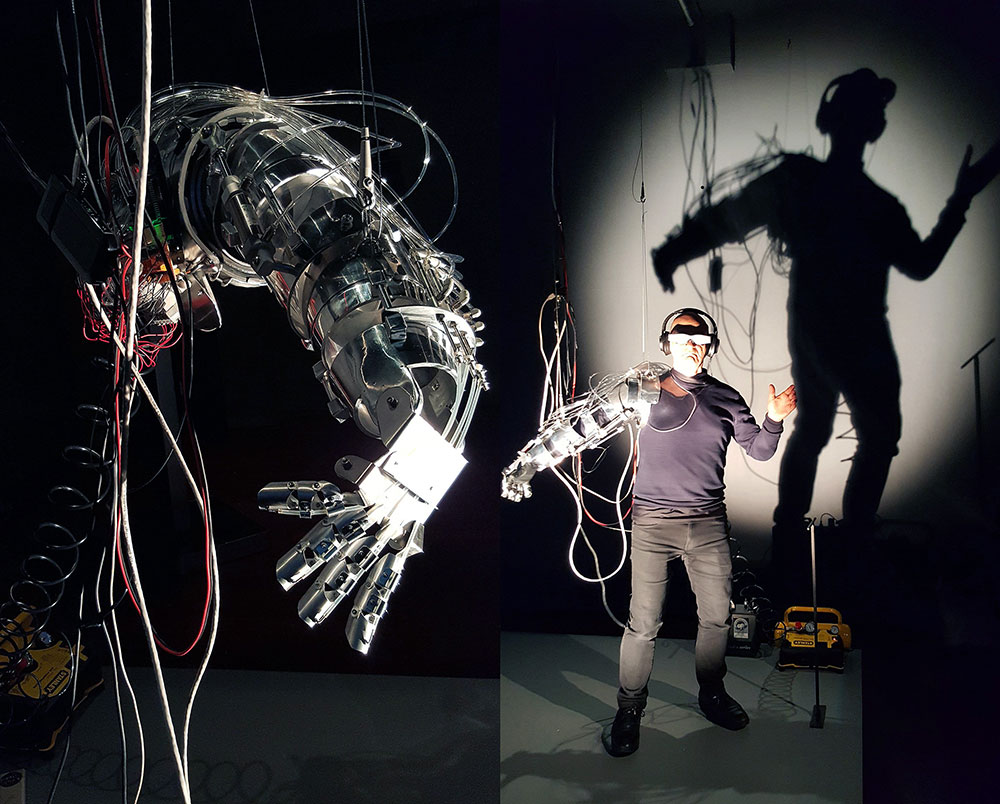
There is yet another remarkable correspondence between the worlds of dance and modern technology: all modern techniques take us back to the human body. Teletechnology places man in the centre of a world without any relation to the ground, and where the horizon as the natural limit of vision has been overcome with radar and satellites. In teletechnology we are transhorizon and without ground: deterritorialized in the true sense of the word. Technology allows man to resurrect as the centre of the world. In the make is the technologically induced egocentric man. It is the irony of all technology that the conquests of the world it made possible, finally lead to an egocentration without rival.
This is where the body of modern communication techniques meets the body of the dancer. The dancer who is busy preventing herself from falling certainly is dedicated to some sort of egocentration. In order not to fall, to be able to rotate and to orient herself to the audience, she permanently is in need of a certain egocentration.
This description however does not cover completely the setting of the dancer. Peculiar of dance namely is the efficacy of a typical mix, composed of the will of the dancer and forces from outside. Dancing is a mysterious incantation of inert elements that occurs somewhere between inanimate matter and animated action. This relates the dancer directly to St. Francis of Assisi, who claimed that there is brotherhood between the animated and the inanimate.
The dancer performs her incantation with the gestures of her body, thereby integrating the ground to propel herself, the gravity to come down again and the audience to orientate herself to.
When we dance we participate in a mysterious conspiracy between the inspired and the undefiled.
Dance makes it difficult for us to hold on to the distinction between the spiritual and the material, between spiritualism and materialism.
Could dance then be a paragon of spiritual materialism?
One thing is sure; when a Tao priest meditates and prays, he also dances.
1) Rudolf Laban, Choreutik, Grundlagen der Raum-Harmonielehre des Tanzes (1926), aus dem Englischen übertragen von Claude Perrottet, Wilhelmshaven; Noetzel, Heinrichshofen- Bücher, 1991
2) Rudolf von Laban, Choreutics [annotated and ed. by Lisa Ullmann], London; Macdonald & Evans, 1966/ Repr. Rudolf Laban, Choreutics, London; Dance Books Ltd, November 1, 2011/ http://www.balonindonesia.com/choreutics.pdf / https://sites.google.com/site/pharicingled/choreutics-78808334
3) “Gravitational space” (conversation between Paul Virilio and Laurence Louppe) in: Traces of Dance, Drawings and Notations of Choreographers, Paris; Paris; Éditions Dis Voir, 1994
4) The project has been published in Elisabeth Diller and Ricardo Scofidio, Flesh, Architectural Probes, New York; Princeton Architectural Press, 1994
5) Arch+ 124/125 Leicht und Schwer (Dec. 1994) p. 71 (70 en 73)
6) Martin Heidegger, “The Age of the World Picture” (1938), in: Off the Beaten Track (1950) (ed. and transl. by Julian Young and Kenneth Haynes), Cambridge; Cambridge University Press, 2002 pp. 57- 85 / https://thecharnelhouse.org/wp-content/uploads/2014/11/martin-heidegger-off-the-beaten-track.pdf
Wim Nijenhuis, Arnhem/Cadro, 2004/2017
Selection of Images Wim Nijenhuis
Bibliography
Arch+ 124-125 Leicht und Schwer (1994)
Arch+ 117 Rem Koolhaas, die Entfaltung der Architektur/unfolding Architecture (1993)
Elizabeth Diller and Ricardo Scofidio, Flesh, Architectural Probes, New York; Princeton Architectural Press, 1994
Rudolph von Laban, Choreutik, Grundlagen der Raum-Harmonielehre des Tanzes (1926), aus dem Englischen übertragen von Claude Perrottet, Wilhelmshaven; Noetzel, Heinrichshofen- Bücher, 1991
Rudolf von Laban, Choreutics [annotated and ed. by Lisa Ullmann], London; Macdonald & Evans, 1966
Repr. Rudolf Laban, Choreutics, London; Dance Books Ltd, November 1, 2011
http://www.balonindonesia.com/choreutics.pdf
https://sites.google.com/site/pharicingled/choreutics-78808334
Laurence Louppe, Traces of Dance, Drawings and Notations of Choreographers, Paris; Éditions Dis Voir, 1994
Terence Riley, Frank Lloyd Wright, Architect, New York; The Museum of Modern Art, (1994) 1998
This article is the edited version of the lecture I gave in 2004 at the ArtEZ Academy of Architecture. It was part of a manifestation I performed together with Thomas Körtvélyessy, teacher at the ArtEZ Dance Academy and specialist in Laban. It was organized by the ArtEZ Academy of Architecture in cooperation with the Arnhem Architecture Centre on the occasion of the opening of the new ArtEZ Dance Academy in Arnhem. During the lecture Thomas performed some basic scales from Laban’s theory, together with the public.

